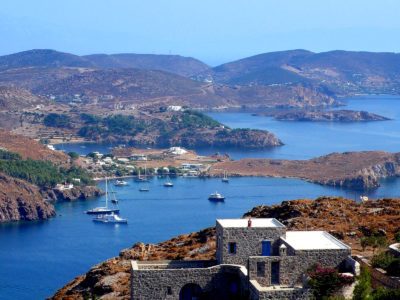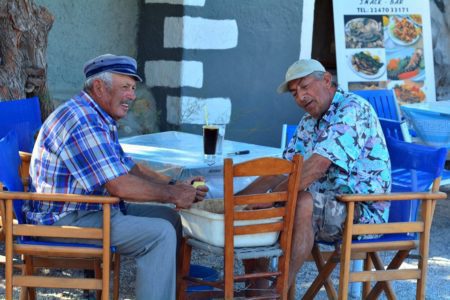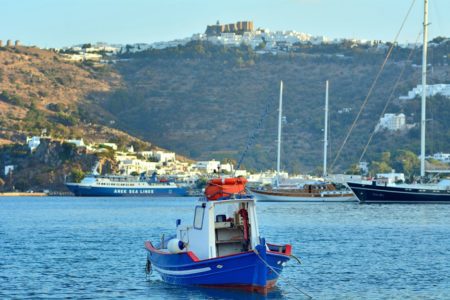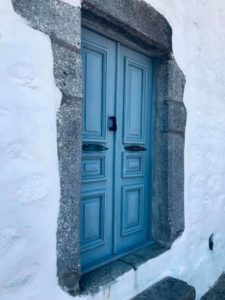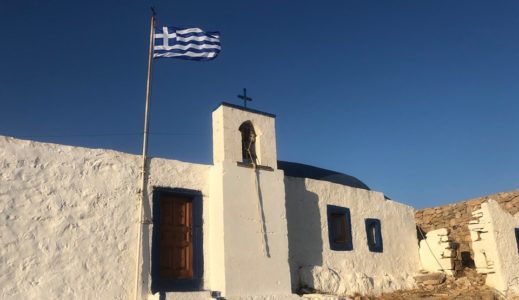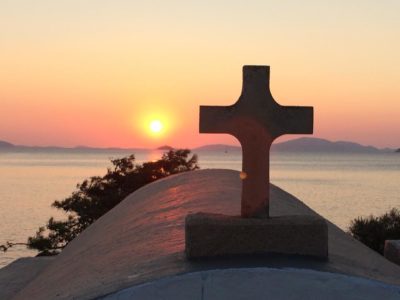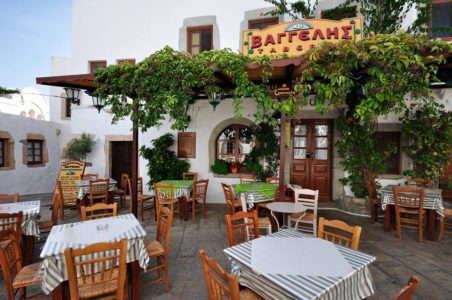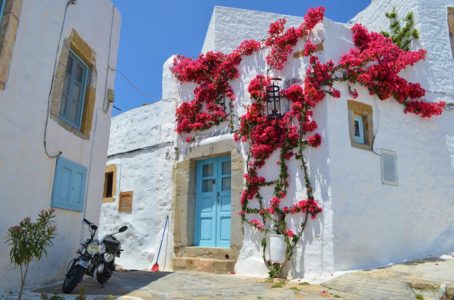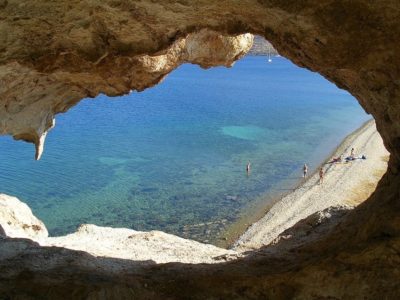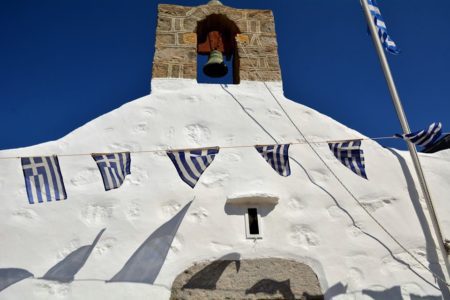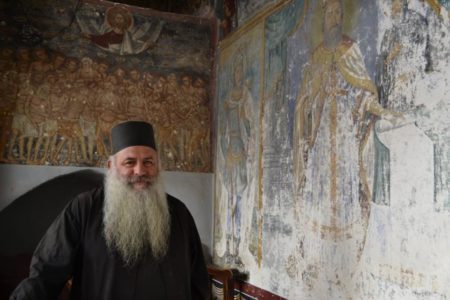Patmos è una delle isole più spettacolari del Dodecaneso per la sua bellezza selvaggia combinata ad una forte impronta storico-religiosa. Viene chiamata l’isola dell’Apocalisse perché l’ultima, e la più mistica, parte della Bibbia fu scritta proprio qui. L’isola greca di Patmos è un’isola con una storia importante, ricca di cultura Bizantina ma anche caratterizzata da un aspetto naturalistico particolare. Infatti, le sue origini vulcaniche le hanno donato strane conformazioni rocciose ed un interno ricco di vallate fertili.
Isola di Patmos – Vacanza a Patmos
L’architettura tradizionale greca, il calore e l’ospitalità degli abitanti sono le ragioni per cui Patmos è l’isola è amata dai visitatori di tutto il mondo. Situata a nordest, tra le ultime isole del Dodecaneso, è circondata da Leros e dalle isole Cicladi di Naxos e Mykonos. Il clima è eccezionale con un’estate molto lunga, secca e calda. Le temperature superano facilmente i 35° ma, grazie al costante e leggero vento, si sopportano bene.
Patmos Isola Sacra
Nel I secolo Patmos venne conquistata dai Romani che la usarono come isola per gli esiliati, tra i quali vi fu, negli anni 95-97, l’Apostolo San Giovanni. Mandato in esilio per la sua predicazione della testimonianza di Gesù, cambiò per sempre il destino dell’isola di Patmos, dove si dedicò alla scrittura dell’ultimo capitolo della Bibbia.
Inoltre, verso nord, sulla strada che da Kambos porta a Geranòs nella pianura di Livadi, numerosa è la presenza di piccolissime comunità di clausura votate al ritiro spirituale. Si ritiene che qui, nei primi dell’Ottocento, un vero e proprio movimento di asceti, noto come Kolivades, era determinato a riportare la fede cristiana alle sue antiche origini. Le tracce di questo curioso gruppo di eremiti si vedono ancora a Kathisma, vicino alla spiaggia di Lambi, nel ritiro di San Giorgio.
Hora
Hora, la capitale e centro storico di Patmos, insieme al Monastero e alla Grotta dell’Apocalisse, dal 1999 sono sotto la protezione dell’UNESCO. Lo stesso Parlamento Greco ha riconosciuto ufficialmente Patmos come Isola Greca Sacra.
Meta prediletta dei pellegrini ortodossi durante tutto l’arco dell’anno, quest’isola è molto frequentata anche dagli escursionisti in arrivo con le navi e caicchi in crociera nel Dodecaneso.
E’ costruita in stile cicladico con casette piccole intervallate da cortili interni, gallerie e vicoli stretti intinti di calce, il tutto racchiuso dalla Fortezza Medievale che coincide con l’imponente Monastero di San Giovanni.
La visita più importante di Patmos è quella del maestoso complesso monastico dedicato all’Evangelista, tra le più clamorose meraviglie architettoniche dell’Egeo. La sua fondazione risale al 1088 ad opera del monaco Christodoulos. Da alcune tracce, sembra che qui avesse avuto sede un tempio arcaico dedicato alla Dea della caccia, Artemide.
Le altre località
Skala conta circa duemila abitanti ed è il centro amministrativo e commerciale di Patmos. Il suo porto imponente ospita numerose barche di pescatori ma anche traghetti e navi da crociera. Il lungomare, caratterizzato da alcuni edifici risalenti all’occupazione Italiana e da numerose taverne greche e caffetterie, termina nella parte nord della zona turistica di Neteria. Qui vi sono la maggior parte delle strutture alberghiere di Patmos e una piccola spiaggia di sabbia molto frequentata dai visitatori in escursione sull’isola.
Aspettatevi, dunque, di trovare il porto di Skala e la città Bizantina di Hora molto affollate durante il giorno. Le altre località dell’isola, meno frequentate dai turisti in escursione, mantengono invece una certa tranquillità.
Le spiagge
La strada principale porta da Skala verso il villaggio di Kambos, distante circa 5 km. La prima spiaggia lungo questa strada, raggiungibile anche a piedi o con barche – taxi, è la Melì Beach. Molto più tranquilla è la vicina baia Agriolivado dove troverete una spiaggia di sabbia e ciottoli e un porticciolo turistico presso il quale, durante tutta l’estate, gettano l’ancora alcuni yachts privati. Da Kambos, la strada prosegue verso la punta di Alyki dove si trova Vaghià, una sottile striscia di ghiaia con alberi di tamarisco. Qui il mare ha acque un po’ fredde ed un fondale profondo, ma è un ottimo luogo dove praticare lo snorkeling. Più avanti c’è Livadi tou Gernou, una baia chiusa dall’isolotto di San Giorgio.
Verso nord, ci sono diverse baie tra le quali Lambi, una spiaggia di ciottoli rossi. Tornando sulla costa ovest si trova la baia di Lefkes, unico punto accessibile della costa occidentale, molto rocciosa e fortemente battuta dai venti del nord. Verso sud si trovano due strade: una costiera, che porta alla località turistica di Grikos, e l’altra che raggiunge la parte estrema dell’isola di Patmos passando per Hora. Grikos è una piccola località turistica costruita intorno al villaggio di pescatori. Un’ultima spiaggia che indubbiamente merita è Psilì Ammos, a 20 minuti a piedi lungo un sentiero. Come indica il nome greco, è una spiaggia di sabbia finissima e mare azzurro.
Dove mangiare
A Patmos ci sono molti ristoranti e taverne dove si può trovare un’ottima cucina greca, piatti e specialità locali, oltre naturalmente, al pesce fresco. Generalmente nell’isola di Patmos, e in particolare a Skala e Hora, si spende un po’ di più rispetto ad altre isole Greche, i ristoranti sono per lo più turistici e sempre molto affollati. Presso il porto di Skala la maggior parte dei ristoranti sono concentrati lungo la via parallela al porto; di giorno sono molto frequentati dai gruppi in escursione giornaliera delle navi crociera, mentre la sera diventano più caratteristici con i tavolini allestiti direttamente in strada.
Patmos è turismo sostenibile
Nonostante la grande fama, Patmos non è ancora divenuta una meta del turismo di massa e oltre ad essere scelta per un turismo religioso, incontra anche i gusti del turista più riservato e dai gusti sofisticati. Anche in futuro difficilmente potrà raggiungere livelli di turismo superiori a quelli attuali.
Molte limitazioni sono infatti prescritte dall’Istituto Monastico da sempre contrario alla costruzione di un aeroporto e ad altri progetti per lo sviluppo urbanistico e infrastrutturale dell’isola di Patmos. Così, anche se vi sono buone possibilità di lavoro nel commercio e nel turismo durante i mesi estivi, l’agricoltura e la pastorizia hanno ancora un ruolo predominante. Fanno parte del Comune di Patmos anche le vicine piccole isole greche di Arki e Marathi con i loro 60 abitanti.


